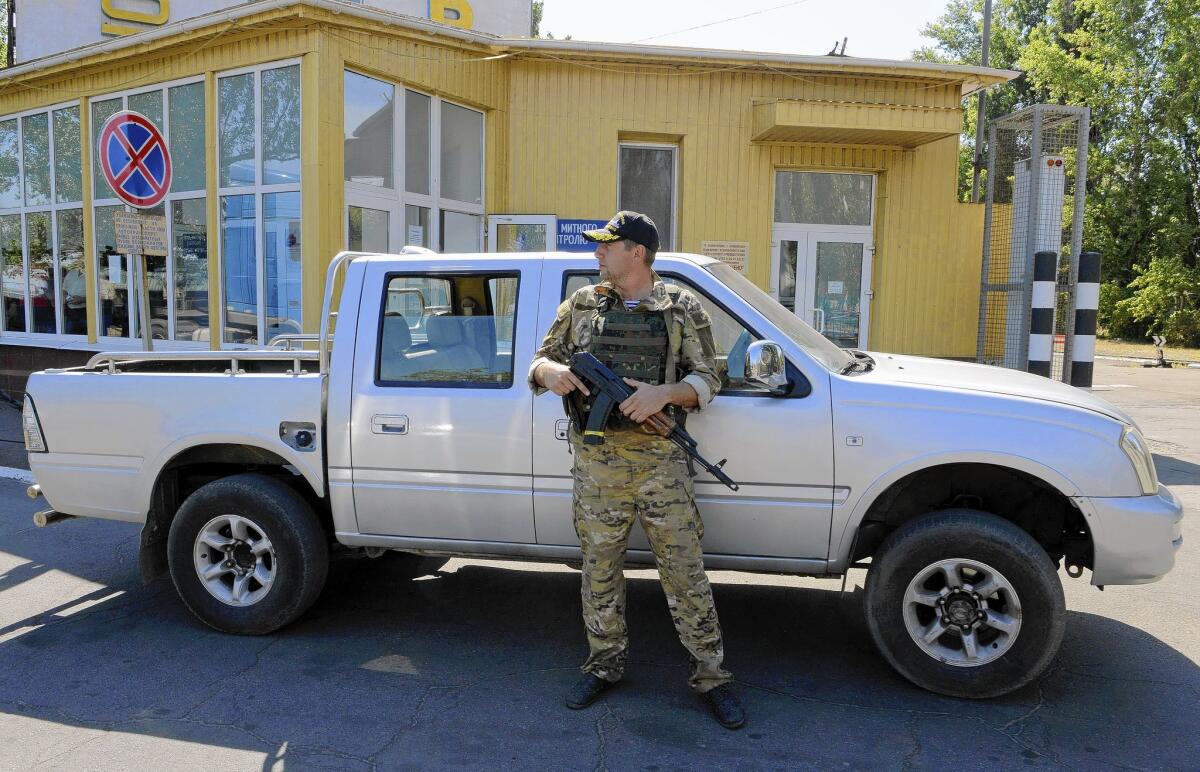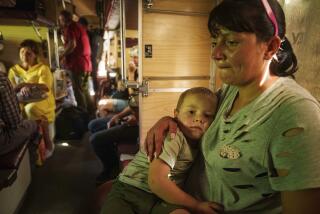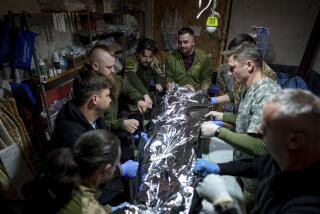Ukraine port city near Russia fears it will become next battleground

- Share via
Reporting from Mariupol, Ukraine — With pro-Russia separatists once again gaining ground in the bloody conflict for control of Ukraine’s eastern industrial heartland, a sense of panic has overcome this port city on the shores of the Sea of Azov.
Late last week, Ukraine said as many as 1,000 Russian troops had crossed the border just 40 miles from Mariupol. Within hours, anxious residents began preparing for what many fear will be the next battle between Ukrainian government forces and a separatist army trying to expand its territory south and create an independent state it calls Novorossiya, or New Russia.
Volunteers sprang into action. Along the city limits, residents showed up with shovels and backhoes to dig trenches to defend the city from attack. The Ukrainian army built additional posts at every feasible entry point into this city of half a million people.
Thousands of others fled the city by bus, train or car, hoping to avoid what they have seen happen to the nearby cities of Donetsk and Luhansk. There, heavy shelling and fighting have claimed as many as 2,600 lives since the conflict started in April, according to the latest figures from the United Nations.
But perhaps nowhere was the fear more palpable Monday than in the headquarters of the New Mariupol volunteer organization, where Marina Odnorog was frantically trying to coordinate the delivery of food and basic supplies to the “boys on the front line.”
Odnorog said her main task was to get more medical supplies to a war hospital being set up in the center of the city. On Sunday, she organized the delivery of binoculars to a pro-Ukraine volunteer battalion stationed about 15 miles to the east.
“Everybody in the city is mobilizing for this war,” Odnorog said in the organization’s two-room office, which also serves as a warehouse for sleeping bags, packages of macaroni and other items that Ukraine’s poorly funded army has been struggling to provide its troops.
Mariupol is home to several large metallurgy plants and a large port on the Sea of Azov, making it an economically and strategically important city in eastern Ukraine. After Russia annexed the Black Sea peninsula of Crimea in March, Mariupol’s port became even more important to eastern Ukraine’s economy.
There is fear that separatist troops, backed by Russia, could try to create a corridor through Mariupol that would link the annexed Crimea with Russia.
The Ukrainian government’s claim that Russian troops entered Ukraine was backed by the North Atlantic Treaty Organization, which said it had satellite images showing such troop and hardware movement into Ukrainian territory.
On Monday, the spokesman for the Ukrainian National Security and Defense Council, Col. Andriy Lysenko, said there were at least four Russian army battalions and tactical groups operating in Ukraine.
Russia consistently has denied that its troops are in Ukraine. It has also repeatedly denied that it is supporting and funding the pro-Russia separatist movement, despite statements from separatist leaders that as many as 4,000 Russian soldiers “on vacation” were fighting alongside the separatists.
There were no obvious signs of Russian soldiers or equipment Sunday in Mariupol or Novoazovsk, the border town where Ukraine says the troops crossed over late last week. A battalion of separatists had taken control in Novoazovsk.
Residents there were for the most part unfazed by the presence of the armed separatists, which have parked several tanks at the entrance to the small city and taken positions along the main road.
“If these guys are going to keep the war from coming here to us, they can stay,” said Ivan Alyokhin, 68, a retired tractor machinist.
That may be wishful thinking. But the separatists have made significant territorial gains in recent days. On Monday, Ukraine acknowledged that its forces had retreated from the Luhansk regional airport and the city of Ilovaysk, just south of Donetsk.
Ilovaysk was seen as a key position along the road between Donetsk and Russia. For days, separatists encircled the city and fiercely attacked the Ukrainian battalions trapped inside.
Fighters with the all-volunteer Shakhtarsk Battalion said that when they retreated from the city late last week, Russian soldiers were part of the encircling fighters.
Separatist gains in the battlefront with what, by most accounts, appears to be Russian military assistance could signal that Russian President Vladimir Putin is prepared to create a constant state of conflict in Ukraine, much as has happened in Georgia’s breakaway regions of Abkhazia and South Ossetia, said Timothy Ash, an analyst at Standard Bank in London who monitors Russia and Ukraine.
“His strategy is absolutely clear, even if his tactics have changed as the conflict carried on,” Ash said. “Putin is willing to do whatever it takes to ensure that Ukraine can’t join NATO” or the European Union.
As a result, Ukraine faces difficult choices, he said.
It must decide whether it will keep fighting Russia at the painful cost of many more lives, allow a stalemate to continue in the conflict with separatists or give in to Putin’s demands, Ash said.
“The scenario is pretty grim,” he said.
Ayres is a special correspondent.
More to Read
Sign up for Essential California
The most important California stories and recommendations in your inbox every morning.
You may occasionally receive promotional content from the Los Angeles Times.














